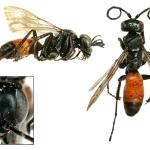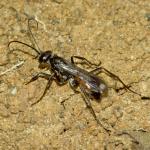Priocnemis exaltata belongs to Priocnemis sens. str. Males can be identified by examination of the genitalia, and females recognised by the long metapostnotum. It is one of the largest species in its subgenus.
England, common in the south, with scattered records in Wales and Ireland, these mainly on or near the east coast. There is a single isolated record from northern Scotland. Also known from the Channel Islands.
It occurs in much of Europe, although it is absent from the south (Wolf, 1972). France, Belgium, Netherlands, Luxembourg, Italy, Switzerland, Germany, Denmark, Slovenia, Austria, Czech Republic, Slovakia, Poland, Bulgaria, Romania, Belarus, Norway and Finland (Wahis, 2011).
This species is not regarded as being scarce or threatened.
Occurs in a wide range of habitats: woodland, hedgerows, heathland, quarries, brownfield sites, and coastal habitats including cliffs, sand-dunes and even saltmarsh.
A relatively short and late flight period with the majority of records in July and August.
A variety of spiders in the families Lycosidae, Salticidae and Pisauridae; these hunt their prey rather than making webs.
Nests are excavated in soil, often adapting pre-existing cavities.
The wasp has been observed visiting wild carrot and wild angelica (pers. obs.).
No data available.
2012



